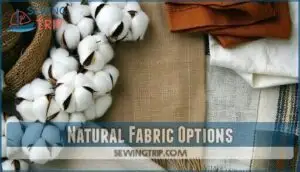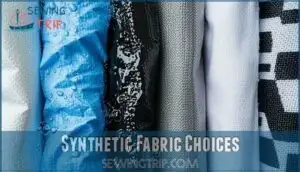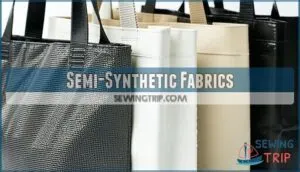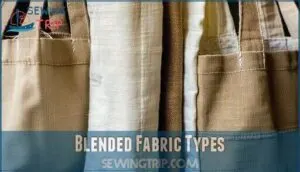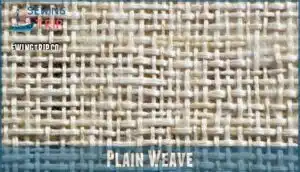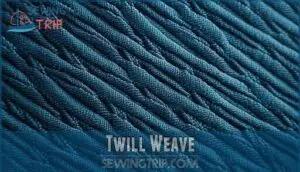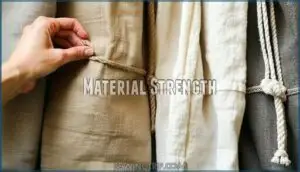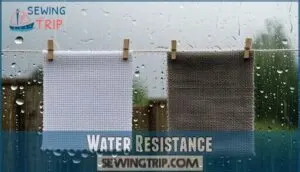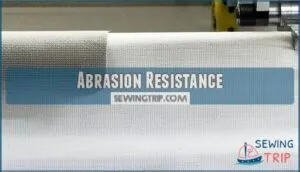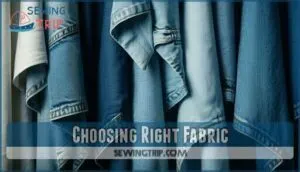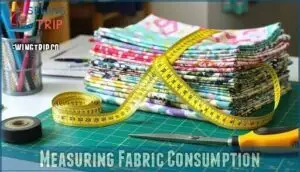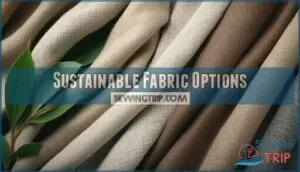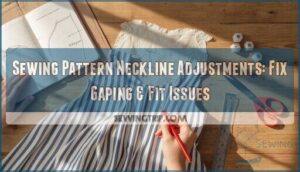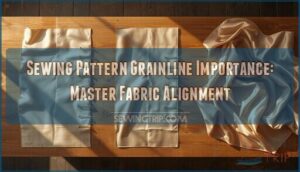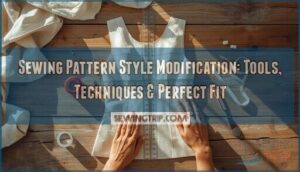This site is supported by our readers. We may earn a commission, at no cost to you, if you purchase through links.
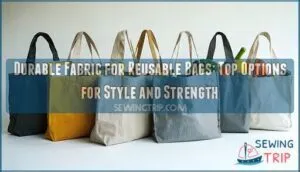
Canvas stands as the workhorse option, withstanding years of grocery runs without complaint.
Hemp offers exceptional durability while being environmentally friendly.
For water resistance, recycled polyester (rPET) provides strength and repurposes plastic bottles.
Cotton duck fabric combines thickness with flexibility, making it perfect for heavier loads.
Nylon and polypropylene offer lightweight strength for bags you’ll fold into pockets.
The right fabric choice depends on your specific needs – whether you’re hauling books or building a collection that stands the test of time.
Table Of Contents
Key Takeaways
- Choose hemp or canvas for their strength, durability, and eco-friendly qualities, perfect for heavy-duty reusable bags.
- Recycled polyester (rPET) gives plastic waste a second life, offering lightweight water resistance and impressive durability.
- Blended fabrics like poly-cotton or jute-cotton combine softness with strength, making them versatile for various carrying needs.
- Match fabric to purpose; breathable cotton mesh works for produce, while rugged nylon suits heavy groceries or travel.
Natural Fabric Options
Natural fabrics like cotton, jute, hemp, and linen offer durability and eco-friendliness, making them ideal for reusable bags.
You’ll find these materials both practical and versatile in balancing strength, style, and sustainability.
Cotton Benefits
Cotton stands out for its softness and versatility.
As a natural fiber, it offers excellent breathability and the biodegradability factor guarantees eco-friendliness.
You’ll love its repair ease, making it last longer.
Organic cotton, cotton canvas, and recycled cotton provide sustainable options.
It’s perfect for food storage, keeping items fresher, or blending options that boost durability and functionality.
Jute Characteristics
Jute, a natural fiber, stands out for its strength, durability, and ecofriendly nature.
Its coarse texture gives a rustic charm, making it perfect for market and produce bags.
As a sustainable bag fabric, jute requires minimal resources to grow, ensuring lower environmental impact.
Jute blends improve softness and flexibility, broadening its applications in reusable bags and eco-conscious designs.
Hemp Advantages
Hemp is a fantastic option for reusable bags. It’s tough, ecofriendly, and grows with minimal resources.
This durable fabric stands out for strength and sustainability. Here’s why: Hemp cultivation can even detoxify the soil.
- Hemp Strength: It’s one of the strongest natural fibers.
- Eco-Friendliness: Hemp supports sustainable options by needing less water.
- Blending Options: Combined with other fibers, hemp adds durability and versatility.
Linen Features
Beyond hemp lies another excellent choice for your reusable bags.
Linen, derived from flax plants, offers remarkable durability while maintaining a lightweight profile.
Its distinctive texture improves with age, developing character rather than wearing out.
The natural fibers provide excellent breathability and moderate water resistance.
When sourcing linen for bag materials, look for medium-weight varieties that balance strength with flexibility, ensuring your fabric types match your specific needs, which is crucial for the overall quality.
Synthetic Fabric Choices
You’ll find synthetic fabrics like polyester, polypropylene, nylon, and Tyvek offer superior strength and water resistance for your reusable bags.
These materials provide excellent durability while keeping your bags lightweight, making them practical options for everything from grocery shopping to travel, which is due to their durability.
Polypropylene Uses
While natural fabrics offer eco-friendly options, synthetic materials like polypropylene (PP) have revolutionized the reusable bag industry.
You’ll find PP in countless everyday applications due to its exceptional durability and versatility.
Polypropylene’s standout qualities for reusable bags include:
- Superior water resistance for grocery shopping in all weather conditions
- Impressive strength-to-weight ratio that supports heavy loads
- Cost-effective production making PP bags affordable
- Easy-to-clean surface that resists stains
- Ability to accept vibrant printing for stylish designs
Polyester Benefits
While polypropylene offers excellent durability, polyester stands out for its remarkable strength and versatility in reusable bags.
You’ll find polyester exceptionally practical with its tear resistance and water-repellent properties. It’s also lightweight and won’t weigh you down during shopping trips.
Polyester, like other completely synthetic fibers, is derived from petroleum-based chemicals.
| Feature | Benefit | Application |
|---|---|---|
| Durability | Resists tearing and abrasions | Heavy grocery loads |
| Water-resistance | Quick-drying capability | All-weather use |
| Wrinkle resistance | Maintains shape | Travel bags |
| Color retention | Vibrant appearance | Branded totes |
| Cost-effectiveness | Budget-friendly option | Bulk production |
Nylon Features
Versatility defines nylon fabric for your reusable bags.
Its exceptional strength-to-weight ratio makes it ideal for daily use.
Ripstop nylon fabric offers tear resistance, while waterproof varieties keep contents dry.
You’ll appreciate how nylon’s durability withstands heavy loads and frequent use.
Though not biodegradable, nylon’s longevity contributes to sustainability through extended product lifecycles.
Many manufacturers now offer recycled nylon options, balancing performance with environmental concerns.
Tyvek Applications
While nylon offers flexibility, Tyvek brings something entirely different to reusable bags.
This high-density polyethylene material combines paper, film, and fabric properties in one waterresistant bag solution.
It’s surprisingly lightweight yet tear-resistant, withstanding repeated folding without damage.
Tyvek durability makes it perfect for grocery totes, while its printability allows for customized designs.
Best of all, when your durable shopping bag eventually wears out, Tyvek recycling options make disposal eco-friendly.
Semi-Synthetic Fabrics
Semi-synthetic fabrics offer an excellent middle ground between natural and fully synthetic materials, combining durability with environmental benefits for your reusable bag needs.
You’ll find options like recycled polyester (rPET) and laminated fabrics that provide water resistance and strength while reducing plastic waste.
Recycled Polyester
Recycled polyester takes those plastic bottles you toss in the recycling bin and transforms them into durable fabric for your bags.
Unlike virgin synthetics, rPET substantially reduces environmental impact while maintaining impressive water resistance and strength.
You’ll find it’s nearly identical to regular polyester in durability but comes with the added satisfaction of knowing you’re giving plastic waste a second life.
Plus, it’s remarkably stain-resistant for everyday use.
RPET Fabric
The remarkable RPET fabric transforms plastic bottles into stylish, durable reusable bags.
This innovative recycled material offers a perfect blend of sustainability and functionality for your everyday carrying needs.
- Reduces landfill waste while maintaining excellent durability
- Requires 70% less energy in RPET production compared to virgin polyester
- Features water-resistant properties ideal for protecting your belongings
- Supports circular economy through continuous RPET recycling possibilities
Laminated Fabrics
While RPET gives plastic bottles a second life, laminated fabrics take durability to another level.
These materials combine two or more layers with a polymer film bonded using heat or adhesive.
You’ll appreciate their water resistance and protective qualities when carrying groceries in the rain.
Laminated fabrics come in various types and substantially enhance durability while remaining cost-effective. They’re easy to clean too—just wipe with a damp cloth when spills happen.
Blended Fabric Types
You’ll find that blended fabrics combine the best properties of different materials to create superior reusable bags that withstand daily use.
These strategic combinations, such as poly-cotton, jute-cotton, and cotton-nylon blends, offer enhanced durability while maintaining appealing aesthetic qualities, which make them superior reusable bags.
Poly-Cotton Blend
After exploring synthetic alternatives, let’s examine poly-cotton blend – a perfect marriage of natural and synthetic fibers for reusable bags.
This versatile blend combines polyester’s durability with cotton’s breathability, creating an ideal balance for everyday use.
The standard blend ratio is typically 65% polyester and 35% cotton, offering:
- Excellent wrinkle resistance for bags that maintain their shape
- Superior dye compatibility for vibrant, long-lasting colors
- Cost-effectiveness without sacrificing quality or durability
The combination of these features makes the poly-cotton blend a practical choice for everyday use, providing a balance of durability, aesthetic appeal, and affordability.
Jute-Cotton Blend
The versatility of jute-cotton blend makes it a standout choice for reusable bags.
This natural fiber combination offers excellent blend durability while maintaining a softer feel than pure jute.
You’ll appreciate how the cotton softens the coarse jute texture without sacrificing strength.
The environmental impact is minimal as both fibers are biodegradable.
For canvas bag fabric that balances rustic aesthetics with practical function, jute-cotton delivers impressive weave impact at a reasonable cost.
Cotton-Nylon Blend
You’ll find cotton-nylon blend fabrics right up at the top of the list for reusable bag materials.
This powerful combination merges cotton’s natural comfort with nylon’s exceptional strength.
Four key benefits of cotton-nylon blends for your bags:
- Enhanced durability without sacrificing softness
- Superior resistance to daily wear and tear
- Improved flexibility for various bag applications
- Balanced cost-effectiveness compared to pure materials
The benefits of using cotton-nylon blends include a perfect blend of natural comfort and exceptional properties, making them ideal for reusable bags.
Woven Fabric Varieties
You’ll find that the weave pattern of your reusable bag fabric substantially impacts its durability and appearance, with options ranging from sturdy plain weave to textured twill and smooth satin constructions.
The specific weaving technique determines how well your bag will hold up to daily use, with each pattern offering distinct advantages for different carrying needs, making durability a key factor.
Plain Weave
Plain weave is the most straightforward weave structure used in reusable bags.
Its simple over-under pattern gives fabric excellent stability and durability. You’ll find this weave in common materials like cotton and canvas, where it creates a balanced, even surface that’s perfect for printing logos or designs.
Plain weave variations offer different textures while maintaining strength—a key advantage when you need bags that withstand daily use, providing a balanced and even surface.
Twill Weave
Twill weave creates that distinctive diagonal pattern you’ve likely noticed on your favorite denim bags.
This structured weaving technique delivers superior durability for everyday use.
- Offers greater fabric density than plain weave, enhancing bag durability
- Creates attractive diagonal lines that hide stains better than other weaves
- Provides excellent flexibility while maintaining structural integrity
Twill variations like herringbone add visual interest while maintaining the strength that makes twill-woven fabrics ideal for long-lasting reusable bags.
Satin Weave
While twill brings texture to your bags, satin weave offers a completely different experience.
This luxurious weave creates a smooth, glossy surface that elevates reusable bags to statement pieces.
Though less durable than other fabric types, satin’s aesthetics make it perfect for special occasions.
The cost runs higher than standard options, but faux satin provides a budget-friendly alternative while maintaining that distinctive sheen that catches everyone’s eye.
Fabric Durability Factors
You’ll need to keep in mind key durability factors like material strength, water resistance, and abrasion resistance when selecting fabric for your reusable bags.
These elements determine how well your bag will withstand regular use, unexpected weather, and the constant friction from carrying everything from sharp-cornered cereal boxes to heavy canned goods, considering factors like abrasion resistance.
Material Strength
When choosing a strong bag fabric, focus on tensile strength and abrasion resistance.
A dense weave enhances durability, ensuring your bag can handle heavy loads without tearing.
High load capacity and tear-resistant fabric are key for long-term use.
For example, canvas and hemp excel in toughness, making them great options for reliable, durable fabric performance you can count on.
Synthetic options such as polyester offer durability as well, providing a durable alternative to natural fibers.
Water Resistance
Your bag’s water resistance is essential for protecting contents from unexpected rain or spills.
Durable fabrics like 1050D ballistic nylon and X-Pac RX30 offer superior protection, while natural options like quality canvas provide moderate resistance through tight weaving.
For maximum protection, look for reusable shopping bags with waterproof coatings, hydrophobic treatments, or PVC backing.
Seam sealing further enhances water-resistant bag performance by preventing moisture infiltration at vulnerable points.
Abrasion Resistance
Why does abrasion resistance matter for your reusable bags? It determines how well your bag withstands daily friction and wear.
Nylon and Cordura offer exceptional durability for high-frequency usage.
- Nylon provides exceptional tensile strength and abrasion resistance for heavy-duty applications
- Polyester resists pilling and fraying, maintaining structural integrity longer
- Cordura’s high-tenacity nylon construction offers superior puncture resistance
- Kozane Invicta achieves the highest EN388 Level 4 abrasion resistance, showing minimal wear after 8,000 cycles
Choosing Right Fabric
You’ll need to match your fabric choice to your specific carrying needs, considering factors like load weight, frequency of use, and environmental impact.
The right material balances durability with your style preferences, whether you prefer natural options like canvas and hemp or synthetic alternatives such as nylon and recycled polyester.
Sustainability Considerations
The sustainability of your reusable bag fabric matters as much as its durability.
When selecting materials, consider the environmental impact through their entire lifecycle. Cotton requires significant water usage but is biodegradable, while recycled fabric bags reduce waste.
Look for eco-friendly dyes and ethical sourcing to minimize your carbon footprint.
Hemp offers excellent sustainability credentials with minimal environmental impact compared to other durable fabrics.
Style and Design
Beyond durability, your bag’s style and design play a vital role in its appeal.
Consider bag aesthetics that match your target audience—whether through vibrant print patterns or minimal color palettes.
Custom designs can transform functional items into fashion statements.
Natural fabrics often create rustic charm, while synthetics offer sleek modernity.
The right fabric texture and weight substantially impact your bag’s overall style and visual appeal, creating a unique blend of form and function with custom designs.
Intended Use
While a stylish bag catches eyes, your intended use determines the fabric you’ll need.
For grocery shopping, opt for cotton or hemp that handles heavy loads without splitting seams.
Travel bags benefit from nylon’s lightweight strength.
Produce storage works best with breathable cotton mesh.
Everyday use demands durable canvas.
Your reusable grocery bag’s success depends on matching the fabric to its purpose – a heavy-duty tote fabric for books won’t necessarily work for delicate produce.
Fabric Maintenance Tips
You’ll extend the lifespan of your reusable bags substantially by implementing proper maintenance routines specific to each fabric type.
Regular cleaning and correct storage techniques prevent premature wear and maintain structural integrity, ensuring your bags remain functional for years to come, which is crucial for proper maintenance.
Cleaning Methods
Now that you’ve selected the perfect fabric for your bags, keeping them clean guarantees they last even longer.
For cotton and canvas bags, machine wash in cold water with mild detergent. Synthetic fabrics like nylon and polyester need gentle cycles.
Spot clean jute with a damp cloth—never submerge it. For stubborn stains, pre-treat with vinegar solution.
Consider using a specialized cleaning solution for tougher stains. Always air dry your reusable bag fabric to prevent shrinkage and maintain durability.
Storage Advice
Now that your bags are clean, proper storage is key to maintaining their durability.
Store your reusable bags in dry, well-ventilated areas to prevent mildew and fabric deterioration.
- Fold bags consistently using the same technique to maximize space and minimize wrinkles
- Keep fabric bags away from direct sunlight to prevent color fading
- Hang heavier canvas or denim bags on hooks to preserve their shape
- Use organizing systems like boxes or bins to keep different fabric options easily accessible, which helps in maintaining the bags’ durability.
Repair Techniques
When your favorite reusable bag starts to tear, don’t throw it out! Apply simple repair techniques to extend its lifespan.
For small tears, use a running stitch or adhesive patches. Reinforce handles with extra stitching to prevent future damage.
For larger holes, sew on durable patches slightly larger than the damaged area.
Zipper repairs may require replacing the slider or realigning teeth for smooth operation. Consider products for bag mending for convenient solutions to make the process easier and extend the life of your reusable bag with durable patches.
Measuring Fabric Consumption
You’ll need to calculate the exact amount of fabric required for your reusable bags to minimize waste and control costs.
Accurate measurements of your pattern pieces, including seam allowances and any decorative elements, will help you optimize material usage and reduce environmental impact.
Calculating Fabric Needs
Now that you know how to maintain your bags, let’s get practical about fabric calculations. Determining the right amount of fabric prevents costly mistakes when creating reusable bags.
To calculate your fabric needs:
- Measure your bag size and add seam allowance (typically ½ inch on all sides)
- Consider fabric width when planning pattern layout
- Factor in extra material for pattern matching or directional prints
- Multiply length by width to determine total fabric consumption
This approach maximizes pattern efficiency while minimizing cost per yard. You can also use a fabric calculation tool to simplify the process.
Estimating Fabric Waste
Now that you’ve calculated how much fabric you’ll need, let’s talk about waste. Fabric waste typically ranges from 10-15% of your total fabric consumption.
To estimate accurately, measure your pattern pieces against your fabric width. Some cutting techniques, like nesting similar shapes together, can improve pattern efficiency.
Consider joining fabric recycling programs for scraps or explore upcycling options to minimize environmental impact when creating your reusable bags.
Optimizing Fabric Use
Once you’ve calculated potential waste, you’ll want to maximize every inch of your fabric when making reusable bags. Optimizing fabric use isn’t just cost-effective—it’s environmentally responsible.
- Use nesting techniques for pattern efficiency
- Implement strategic cutting techniques to minimize scraps
- Consider the fabric’s grain line for maximum durability
- Save uniform-sized remnants for pocket additions
- Explore creative reuse options for oddly shaped leftovers
These approaches guarantee sustainable materials go further while maintaining bag durability throughout their lifespan. Remember to factor in seam allowance and ease for accurate measurements.
Sustainable Fabric Options
You’ll find exceptional durability and environmental benefits when you select materials like organic cotton, hemp, or recycled polyester for your reusable bags.
These sustainable options reduce your environmental footprint while providing the strength needed for years of reliable use, making them a great choice for reliable purposes.
Eco-Friendly Materials
With sustainable sourcing becoming increasingly imperative, eco-friendly materials for reusable bags now include organic cotton fabric and natural fiber fabrics.
These ecoconscious fabric options substantially reduce your carbon footprint while maintaining durability.
Hemp, jute, and recycled content materials offer excellent alternatives to conventional plastics.
When shopping for reusable bags, consider both biodegradability factors and ethical production standards to guarantee your choice truly benefits the environment.
Biodegradable Fabrics
Biodegradable fabrics break down naturally when their useful life ends, making them excellent choices for eco-conscious shoppers.
Biodegradable fabrics naturally decompose, blending durability with eco-conscious living, ensuring your reusable bag leaves no lasting trace on the planet.
When selecting biodegradable options for your reusable bags, consider these key varieties:
- Organic cotton fabric decomposes within 1-5 months in composting conditions
- Natural fiber fabrics like jute resist moisture while fully decomposing in 1-2 years
- Hemp offers exceptional durability while maintaining complete biodegradability
These materials minimize landfill impact without microfiber shedding concerns, making them a great option for those looking to reduce their environmental footprint with reusable bags.
Recyclable Fabrics
Recyclable fabrics are giving waste materials a second life in the circular economy.
You’ll find polyester (rPET) made from plastic bottles and nylon from fishing nets among the most durable recycled materials for reusable bags.
These fabrics resist degradation while maintaining strength, and consumer recycling programs and closed-loop systems guarantee your bag can be recycled again when worn out, completing the sustainability cycle with a focus on circular economy.
Frequently Asked Questions (FAQs)
What are reusable bags made of?
Your reusable bags are typically made from natural fabrics like cotton, hemp, and jute, or synthetic materials such as polypropylene, polyester, and nylon.
Many also use canvas, recycled PET, or fabric blends for durability.
What fabrics are reusable shopping bags made of?
Woven with purpose, your shopping bags come in a variety of fabrics.
You’ll find them made of cotton, hemp, jute, canvas, polyester, nylon, or recycled PET.
Each material offers different durability and environmental benefits.
What is the best material for durable bags?
Canvas and hemp stand out as your best options for long-lasting bags.
They’ll withstand heavy loads and regular use without tearing.
Nylon and recycled polyester also offer excellent durability with water-resistant properties.
Which material is best for reusable shopping bags?
Hemp and canvas stand tall as champions for your shopping needs.
You’ll find these materials both sturdy and sustainable, lasting through years of groceries while canvas offers classic durability that won’t let you down.
Are reusable shopping bags durable?
Yes, they’re quite durable when made from quality materials.
Your cotton, hemp, canvas and nylon bags will last for years with proper care.
Many can withstand over 700 uses before showing wear.
What type of fabric is best for a bag?
A staggering 75% of reusable bags fail within one year due to poor fabric choice. For your bag, canvas offers durability, hemp provides strength, and cotton blends give washability with longevity.
What is the most durable fabric for bags?
When you’re shopping for bags that’ll stand the test of time, canvas, hemp, and heavyweight nylon offer exceptional durability.
You’ll find these materials can withstand years of use while maintaining their structure and appearance.
What material is best for reusable produce bags?
Mesh cotton is your ideal choice for produce bags.
It’s breathable, machine-washable, and won’t transfer chemicals to your food.
You’ll appreciate how it allows airflow while keeping fruits and vegetables secure.
What is the most durable fabric for backpacks?
For backpacks that’ll go the distance, you’ll want Cordura or Ballistic nylon.
These specialized nylon fabrics resist abrasion, repel water, and withstand heavy loads while remaining lightweight for your everyday adventures.
What is the best fabric to use for tote bags?
When crafting tote bags, reach for cotton or canvas—they’re like the superheroes of fabrics.
They’re durable, breathable, and eco-friendly, effortlessly balancing function and style for everyday use, whether you’re grocery shopping or heading to work.
Conclusion
Studies show that fabric choice can impact a bag’s lifespan by over 50%.
When selecting durable fabric for reusable bags, focus on material strength, water resistance, and sustainability.
Natural options like hemp or jute provide eco-friendly durability, while synthetics like recycled polyester offer lightweight strength and water resistance.
Semi-synthetic and blended fabrics balance functionality with style.
Understanding your bag’s purpose helps you pick the perfect fabric.
With thoughtful selection, your reusable bag can endure years of use.

